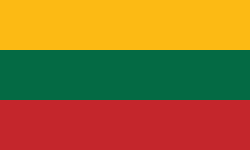Žemaičių Naumiestis (Žemaičių Naumiestis)
Žemaičių Naumiestis (Nowe Miasto, ניישטאָט טאווריג, ניישטאָט סוגינט) is a town in Klaipėda county, Šilutė district municipality in western Lithuania, between Klaipėda and Kaliningrad Oblast. The rivers Šustis, Šelmuo and Lendra flow through it.
For centuries, it was located at the border to Prussia, creating its distinctly multicultural population. Besides Lithuanian inhabitants, its Jewish and German populations—and to some degree Russian—have played significant roles in its history. As a result of the multi-layered events at the eve of World War II, over the course of the war and in the first decade after the war, this multi-cultural population structure was destroyed. It is reflected exclusively in the architectural heritage of Žemaičių Naumiestis. There is the wooden Catholic St. Michael Church (built in 1782), a Protestant church made of stone (built in 1842) and a stone synagogue (built in 1816).
For a long time the town was called Naumiestis (Lithuanian) or Nowe Miasto (Polish). In Yiddish, the town was called Neishtot Sugint (referring to the closely located estate Sugint). Under tsarist rule, the town in 1884 was renamed Aleksandrovsk. This designation was officially valid until 1918. In the 1920s, the town was called Tauragės Naumiestis (Lithuanian) or Neishtot Tavrik (Yiddish) referring to the closely located town Tauragė as opposed to other Lithuanian towns by the name of Naumiestis. In the 1930s the designation Žemaičių Naumiestis was introduced and is valid until today.
For centuries, it was located at the border to Prussia, creating its distinctly multicultural population. Besides Lithuanian inhabitants, its Jewish and German populations—and to some degree Russian—have played significant roles in its history. As a result of the multi-layered events at the eve of World War II, over the course of the war and in the first decade after the war, this multi-cultural population structure was destroyed. It is reflected exclusively in the architectural heritage of Žemaičių Naumiestis. There is the wooden Catholic St. Michael Church (built in 1782), a Protestant church made of stone (built in 1842) and a stone synagogue (built in 1816).
For a long time the town was called Naumiestis (Lithuanian) or Nowe Miasto (Polish). In Yiddish, the town was called Neishtot Sugint (referring to the closely located estate Sugint). Under tsarist rule, the town in 1884 was renamed Aleksandrovsk. This designation was officially valid until 1918. In the 1920s, the town was called Tauragės Naumiestis (Lithuanian) or Neishtot Tavrik (Yiddish) referring to the closely located town Tauragė as opposed to other Lithuanian towns by the name of Naumiestis. In the 1930s the designation Žemaičių Naumiestis was introduced and is valid until today.
Map - Žemaičių Naumiestis (Žemaičių Naumiestis)
Map
Country - Lithuanian_Soviet_Socialist_Republic_(1918–1919)
 |
 |
| Flag of Lithuania | |
Germany had lost World War I and signed the Compiègne Armistice on 11 November 1918. Its military forces then started retreating from the former Ober Ost territories. Two days later, the government of the Soviet Russia renounced the Treaty of Brest-Litovsk, which had assured Lithuania's independence. Soviet forces then launched a westward offensive against Estonia, Latvia, Lithuania, Poland and Ukraine in an effort to spread the global proletarian revolution and replace national independence movements with Soviet republics. Their forces followed retreating German troops and reached Lithuania by the end of December 1918.
Currency / Language
| ISO | Currency | Symbol | Significant figures |
|---|---|---|---|
| EUR | Euro | € | 2 |
| ISO | Language |
|---|---|
| LT | Lithuanian language |
| PL | Polish language |
| RU | Russian language |















